mysql补充
目录
select
1. 查找不同行 distinct
select distinct num from test1;
2. 限制输出行数 limit
select num from test1 limit 5;#限制输出的行数最多5行
select num
from test1 limit 5,5;#第一个五表示从第五行开始,第二个五表示输出五行
#注意行号是从0开始的,所以limit1,1相当于从第二行开始的一行
#mysql还有一种平替语法,limit 4 offset 3 == limit 3,4
- 运行结果:
select * from test1 limit 2,1;
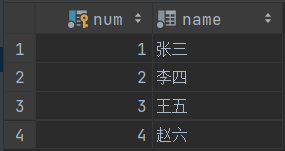

3. 排序 order by
- 根据order by的列来排序输出
select *
from test1 order by num;
#按照num的大小升序输出,默认为升序
select *
from test1
order by num desc; #加上desc之后为降序
select *
from test1
order by num,name; #按照num和name排序,先看num,如果相同再看name
select *
from test1
order by num,name desc; #这里的降序是只针对name的,num还是升序,所以要全降序,需要每个地方都加desc
select * name
from test1
order by age
limit 1;
#limit和order by结合可以输出最小和最大的值
4. 筛选where,条件符and和or
select *
from test1
where age=10;#输出所有年龄为10的信息
where... order by ... #order by要在where 之后要不会出错
select *
from test1
where age <> 10;#输出年龄不等于10的信息
select *
from test1
where age between 10 and 20;#输出年龄在10-20之间的信息
select *
from test1
where age is null;#检查是否有空值
select *
from test1
where age>10 and age<20;#符号 and 表示并,需要同时满足
select *
from test1
where age<10 or age>20;#符号 or 表示或,至少满足其中一个即可
select *
from test1
where age<10 or age>20 and name='111';
#and的优先级是高于or的,所以这个条件可以翻译为,name为'111'并且age>20的,或者age<10的
#解决方法是加括号确定优先级

5. in操作符,和not
In
- in操作符给定取值区间,然后判断是否在区间内
select *
from test1
where age in (10,20,30);#找出age为10,20,30的信息
- 其实可以发现,in和or很类似,之间完全可以互相转换
- 那为什么要使用In,有如下优点

not
- not的作用就是否定
select *
from test1
where age not in (10,20,30);#找出age不为10,20,30的信息
6.通配符like,(%) (_)
- 用来匹配一部分值的特殊字符
( % )
%可以表示任意数量的字符
select *
from test2
where tnum like '0%';#查询后缀有0的内容,%可以表示任意数量的字符,任意数量可以是0
select *
from test2
where tnum like '110%';#前缀有110的内容
select *
from test2
where tnum like '%0%';#某个位置有0
select *
from test2
where tnum like '1%0';#以1开头0结尾
( _ )
- 与%类似,但是只能表示一个字符,并且不能为空
select *
from test2
where tnum like '%1_';#表示1前面可以有任意个字符,后面必须有一个字符
+ 通配符使用所需要注意的

7. 正则表达式
regexp
select *
from test2
where tnum regexp '10'; // 相当于 where tnum like '%10%';
select *
from test2
where tnum regexp '00.1';// .表示可以代替任意一个字符
select *
from test2
where tnum regexp '00[123]';//相当于in,001 002 003,看看那个能匹配上
# [^123] 就是除了123意外的数
# 还可以简化写[1-3],就是[123]的简化版
- 关于为什么有like还使用regexp

OR匹配
select *
from test2
where tnum regexp '00|1';#和or差不多
转义字符
- 一个字符串为'adw.we',我们想通过'.'来找到他,然后输出,然后如果我们
regexp '.',会输出全部内容,因为这里的'.'被认为是代替一个字符了,所以我们要写成regexp '\\.',如果是'\'这样的字符,则需要写成'\\\'
定位符
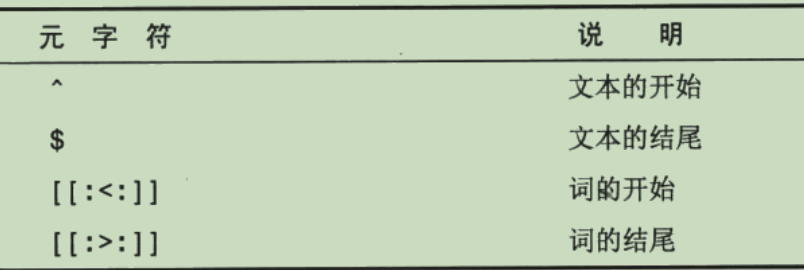
select *
from test2
where tnum regexp '^[0-9\\.]'; #只有在第一个是其中数字时才匹配
计算字段
拼接concat
select concat(num,'(',name,')') //有点像规定输出格式
from test2;
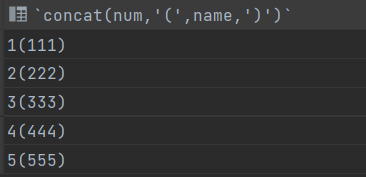
- Trim函数,LTrim函数去除对应列左边的空格,RTrim右边的空格
select RTrim(tnum)
from test2;
别名
- 我们可以将表名替换成一个别名
select concat(num,'(',name,')') as hh
from test2;
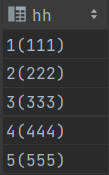
函数
- 调用文本处理函数来实现某些功能
比如:
select upper(str)//upper的功能是将字符转化为大写
from test3;
- 其他常用的文本处理函数


日期处理函数
-
常用的函数

-
一般表示日期的数据类型类datetime,顾名思义就是日期+时间,具体格式为yyyy-mm-nn
select *
from test4
where dat='2002-04-05';
- 问:上面这种写法是否可靠?
答: 不可靠,假如其中有一项数据为'2002-04-05 11:30:30',也就是时间不为00:00:00,那么就无法匹配,所以在匹配时应该只让日期匹配,所以就要用date()函数,取其中的日期,同理还有time()函数,取其中的时间 - 与一些关系符结合
select *
from test4
where date(dat) between '2002-07-01' and '2002-07-31'; //匹配7月份所有数据
select *
from test4
where year(dat)=2002 and month(dat)=7;//也是匹配七月份所有数据,另一种写法
数值处理函数
- 常用的数值处理函数

聚集函数
-
常用函数

-
用法
avg
select avg(num) as avg_num//输出num这一列的平均值
from test1;
count

select count(num) as count_num//输出num列的行数
from test1;
max min
-
返回一列中最大的(最小的)

-
min类似
-
聚集函数中的列,默认为
ALL,也就是选择全部的行,如果前面加上distinct,则只会选择不同的行
分组
-
创建分组
group by - 就是按照group by的列,将其中相同的分为一组用于聚集函数的使用
- group by一定要出现在where之后,order by之前
select age,sum(tnum) as cnt
from test4
group by age;
select age,count(*) as cnt
from test4
group by age;
-
过滤分组
having - having语法和where相似,之所以使用having是因为where只能筛选某些行,不能筛选某些分组
select age,count(*) as cnt,sum(tnum)
from test4
group by age
having count(*) >1;
- 利用
order by排序
select age,sum(tnum) as cnt
from test4
group by age
order by cnt;#按照每组的总和进行排列
select子句小结


子查询
- 可以理解为嵌套查询,一般会和
In一起使用
select age
from test4
where tnum in(select tnum
from test2);//与In一起使用用于子查询
select age,(select count(*) from test2)//计算字段作为子查询
from test4;
联结
-
将多个表互相关联然后筛选
-
联结两个表的例子:
select *
from test4,test2
where test4.tnum = test2.tnum;
select *
from test4 inner join test2
on test2.tnum=test4.tnum;//两种写法最后输出的相同,一个是利用where筛选,一个是用on
-
联结多个表

-
联结所需要注意的

-
联结很多情况下可以很好的替代子查询
创建高级联结
别名
select a.tnum
from test4 a
where a.age=11;
- 使用联结和联结条件

组合查询
union
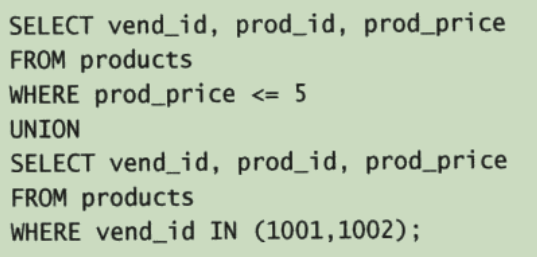
- union组合两个查询时,会自己去重,如果想输出全部行,可以使用
union all - union的规则


insert
insert into test4 values('张三',10,20);
#需要插入全部数据不能有空,而且要保证插入的数据跟列一一对应
insert into test4(name,age,tnum) values('张三',10,20);
#选择要插入数据的列,不选择的列需要是可以为空,或者有默认值
-
很明显可以看出第二种写法要比第一种方法繁琐,那么为什么还需要第二种写法,因为第一种写法,你需要数值与列一一对应,如果原表结构发生变化,那么就会有问题,但第二种写法并不会,更加安全
-
要插入多个数据,我们可以分多条insert语句,或者放在一个语句
insert into test4(name,age,tnum)
values('111',10,20),
('222',20,30);
- 这种写法要比多条insert效率高,因为mysql处理单条语句速度比多条快
- 插入检索出的数据
insert into test4(name,age,tnum)
select name,age,tnum
from test2;
update
- 更新某些数据 update,使用update一定要注意where的使用,防止更新所有行
- 格式
update test4
set age=23
where name='111';//更新单列
update test4
set age=23,
tnum=13
where name='111';//更新多列
update test4
set age=null
where name='111';//删除数据
update ignore test4....//更新发生错误时会停止,加上ignore就是让他发生错误时也继续执行
delete
- delete的作用

delete from test4
where name='111';
delete from test4;
-
delete删除的是整行,不是某个列,列的删除使用update
-
如果要删除全部内容,可以使用
truncate table,这个的速度要比delete快,因为truncate table其实是删除原来的表然后新建立一个 -
不管是delete还是update,都需要注意where的使用,否则会影响所有数据

视图
- 为什么使用视图
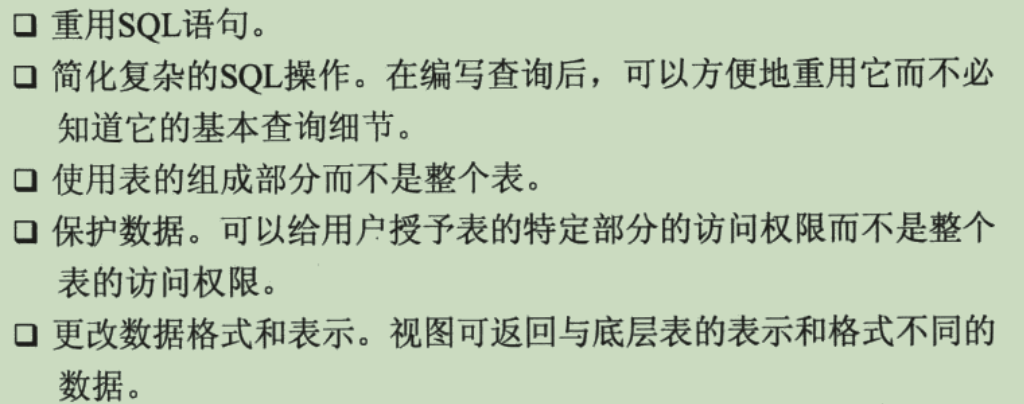
- 视图的性能

- 视图就是一个虚表,可以用这个表来完成一些复杂的联结
- 使用格式

- 用select语句来构造视图

- 视图可以用来更新
存储过程
- 存储过程就是创建一个过程,然后在这个过程里对命令进行批处理,本质上就是一个函数
- 写法:
create procedure solve(//创建
in numa int,
out nameb varchar(20)
)
begin
select name
from test4 where tnum=numa
into nameb;
end;
call solve(30,@total);//调用
- 更复杂的应用
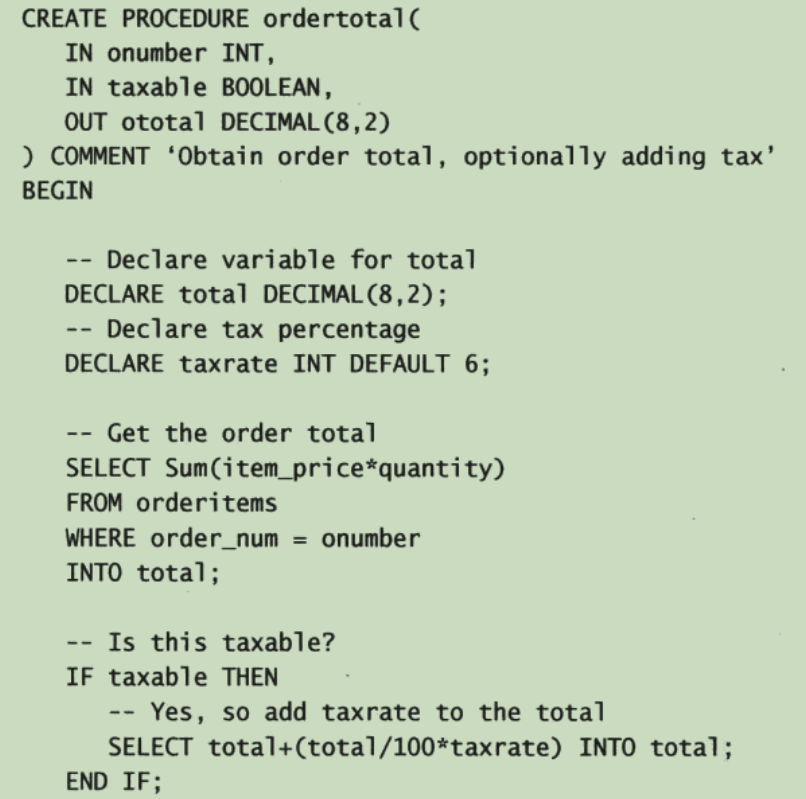
- 其中的declare是创建一个局部变量
- 其中的if语句,有其他的写法,个人倾向于下面的写法
IF 条件表达式
BEGIN
语句1...
END
ELSE
BEGIN
语句2...
END
触发器
- 只可能在
select,update,delete调用时执行,作用也是执行某些过程
create trigger [触发器名]
after/before insert/update/delete on [表名]
for each row
begin
...//要执行的sql语句
end;
- 其中如果要读取数据要存入变量里,然后再读取
begin
select new.num into @tmp;
end;//将新插入的行中的num输入到变量@tmp中
select @tmp;//这样就可以读取
安全管理
- mysql中的用户信息都存储在 mysql数据库中的user表中

- 创建用户
create user np identified by 'password';//创建用户,用户名:np,密码:password
rename user np to nb;//将用户重命名为nb
drop user nb;//删除用户nb
- 设置访问权限
show grants for nb;//查看某个用户的权限
grant select on test2 to ben;//分配权限,给ben用户分配了查询test2的权限
grant select on ccp.test1 to ben;//可以具体说明是那个数据库的那个表
//ccp.* 也可以用正则表示式
-
具体的权限
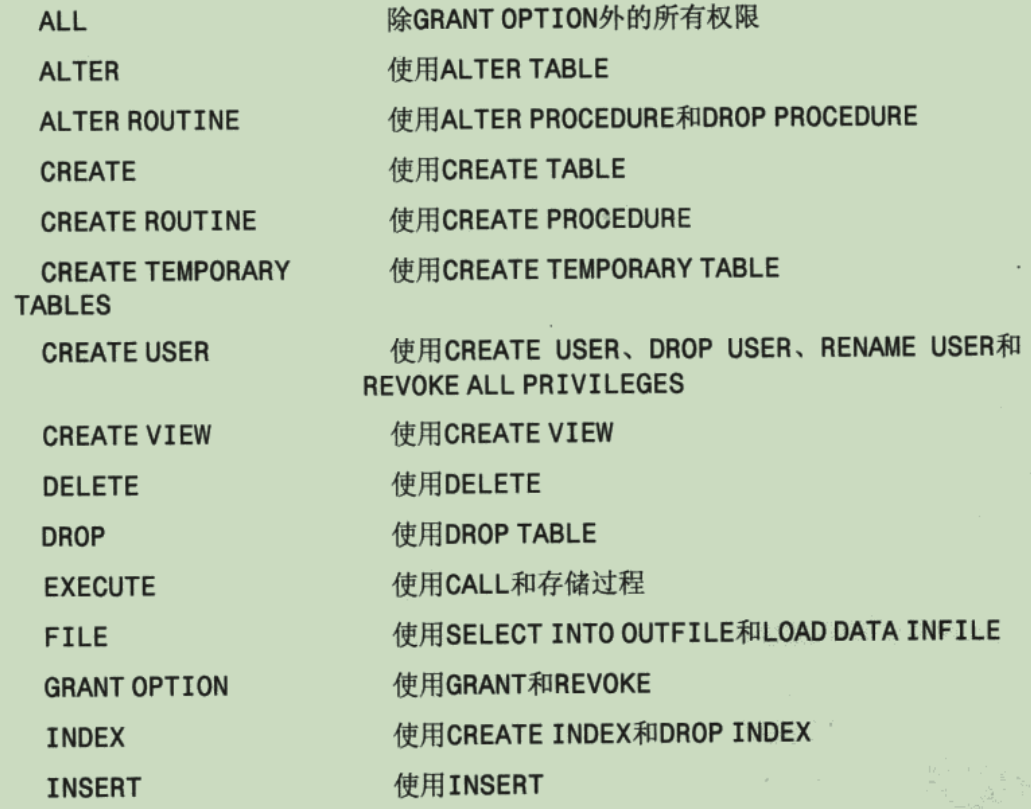


-
更改口令
set password for ben = password('666');//将ben用户的口令更改为666


